PEMFC Poly-Generation Systems: Developments, Merits, and Challenges
Abstract
1. Introduction
2. PEMFC-PGS Units and Technologies
2.1. PEMFC
2.2. Hydrogen Production Technologies
2.3. PEMFC Waste-Heat Recovery (PEMFC-WHR) System
2.3.1. Heat Exchanger
2.3.2. Absorption Chiller
2.3.3. Chemical Heat Pump
2.4. Energy Storage
2.5. Other Subsystems
- Electrical and electronic subsystem: the PEMFC stack generates low-voltage DC which is not suitable for domestic applications. Therefore, electronic conversion devices are normally used to control, adjust, and transform the electrical output of the PEMFC. For example, an inverter is normally used in the PEMFC-PGS to convert the low-voltage DC of the PEMFC to AC compatible with domestic electrical equipment. Also, for integrating the PEMFC-PGS with the national electricity grid, additional pieces of equipment are required to provide frequency synchronisation, control, and other power conditioning to enhance the exportability of the generated power as well as satisfying the quality that is required by the national grid;
- Balance of Plant (BoP) components such as pumps, compressors, humidifiers, valves, pipework, sensors, etc.;
- Auxiliary devices, such as a secondary boiler, providing additional thermal power when the heating generated by the PEMFC-PGS is not sufficient; and
- User-friendly monitoring and control systems, such as smart-meter, LCD touch-screen, and remote control, allowing the customer to interact with the system easily and efficiently.
3. Performance of PEMFC-PGS
3.1. CHP
3.1.1. PEMFC-CHP
3.1.2. HTPEMFC-CHP
3.1.3. Performance under Varying Loads
3.1.4. Optimization of PEMFC-CHP Systems
3.2. CCP
3.3. CCHP
3.4. CWP
4. Commercial Developments
5. Merits and Challenges
6. Conclusions and Outlook
Author Contributions
Funding
Institutional Review Board Statement
Informed Consent Statement
Conflicts of Interest
Abbreviations
| AEL | Alkaline Electrolyser |
| AEM | Anion Exchange Membrane |
| ATR | Autothermal Reforming |
| BoP | Balance of Plant |
| BOA | Butterfly Optimization Algorithm |
| CCS | Carbon Capture and Storage |
| CEG | Centralized Energy Generation |
| CCP | Combined Cooling and Power |
| CCHP | Combined Cooling, Heat, and Power |
| CHP | Combined Heat and Power |
| CWP | Combined Water and Power |
| DCMD | Direct Contact Membrane Distillation |
| DEG | Distributed Energy Generation |
| EES | Electrical Energy Storage |
| EPO | Emperor Penguin Optimization |
| FESR | Fuel Energy Saving Ratio |
| GA | Genetic Algorithm |
| GHG | Greenhouse Gases |
| HP | Heat Pump |
| HWT | Hot-Water Tank |
| ICAB | Improved Collective Animal Behaviour |
| IEPO | Improved Emperor Penguin Optimization |
| LHS | Latent Heat Storage |
| LIB | Lithium Ion Battery |
| MPOA | Marine Predators Optimization Algorithm |
| MR | Membrane Reactor |
| MINLP | Mixed Integer Nonlinear Programming |
| NG | Natural Gas |
| NSGA-II | Non-Sorted Genetic Algorithm II |
| ORC | Organic Rankine Cycle |
| PCM | Phase Change Material |
| PGS | Poly-Generation System |
| PrOx | Preferential Oxidation |
| PSA | Pressure-Swing Adsorption |
| PEMEL | Proton Exchange Membrane Electrolyser |
| PEMFC | Proton Exchange Membrane Fuel Cell |
| RES | Renewable Energy Source |
| SHS | Sensible Heat Storage |
| SOEL | Solid Oxide Electrolyser |
| SR | Steam Reforming |
| TES | Thermal Energy Storage |
| TEG | Thermoelectricity Generator |
| WHR | Waste-Heat Recovery |
| WGS | Water–fGas Shift |
References
- Arsalis, A. A comprehensive review of fuel cell-based micro-combined-heat-and-power systems. Renew. Sustain. Energy Rev. 2019, 105, 391–414. [Google Scholar] [CrossRef]
- Maestre, V.M.; Ortiz, A.; Ortiz, I. Challenges and prospects of renewable hydrogen-based strategies for full decarbonization of stationary power applications. Renew. Sustain. Energy Rev. 2021, 152, 111628. [Google Scholar] [CrossRef]
- Maghanki, M.M.; Ghobadian, B.; Najafi, G.; Galogah, R.J. Micro combined heat and power (MCHP) technologies and applications. Renew. Sustain. Energy Rev. 2013, 28, 510–524. [Google Scholar] [CrossRef]
- Rong, A.; Lahdelma, R. Role of polygeneration in sustainable energy system development challenges and opportunities from optimization viewpoints. Renew. Sustain. Energy Rev. 2016, 53, 363–372. [Google Scholar] [CrossRef]
- Elmer, T.; Worall, M.; Wu, S.; Riffat, S.B. Fuel Cell Technology for Domestic Built Environment Applications: State of-the-Art Review; Elsevier Ltd.: Amsterdam, The Netherlands, 2015; pp. 913–931. [Google Scholar]
- Mahmoud, M.; Ramadan, M.; Naher, S.; Pullen, K.; Baroutaji, A.; Olabi, A.-G. Recent advances in district energy systems: A review. Therm. Sci. Eng. Prog. 2020, 20, 100678. [Google Scholar] [CrossRef]
- Ferguson, A.; Ugursal, V.I. Fuel cell modelling for building cogeneration applications. J. Power Source 2004, 137, 30–42. [Google Scholar] [CrossRef]
- Gigliucci, G.; Petruzzi, L.; Cerelli, E.; Garzisi, A.; la Mendola, A. Demonstration of a residential CHP system based on PEM fuel cells. J. Power Source 2004, 131, 62–68. [Google Scholar] [CrossRef]
- Adam, A.; Fraga, E.S.; Brett, D.J.L. Options for residential building services design using fuel cell based micro-CHP and the potential for heat integration. Appl. Energy 2015, 138, 685–694. [Google Scholar] [CrossRef]
- U.S. Department of Energy Combined Heat & Power and Microgrid Installation Databases. Available online: https://doe.icfwebservices.com/downloads/chp (accessed on 25 July 2021).
- Combined Heat and Power (CHP): The Route to 2050—Call for Evidence—GOV.UK. Available online: https://www.gov.uk/government/consultations/combined-heat-and-power-chp-the-route-to-2050-call-for-evidence (accessed on 25 July 2021).
- The Climate Change Act 2008 (2050 Target Amendment) Order 2019. Available online: https://www.legislation.gov.uk/uksi/2019/1056/note/made (accessed on 22 October 2021).
- 2030 Climate & Energy Framework. Climate Action. Available online: https://ec.europa.eu/clima/policies/strategies/2030_en (accessed on 25 July 2021).
- 2050 Long-Term Strategy. Climate Action. Available online: https://ec.europa.eu/clima/policies/strategies/2050_en (accessed on 25 July 2021).
- Mallapaty, S. How China could be carbon neutral by mid-century. Nature 2020, 586, 482–483. [Google Scholar] [CrossRef]
- FACT SHEET: President Biden Sets 2030 Greenhouse Gas Pollution Reduction Target Aimed at Creating Good-Paying Union Jobs and Securing, U.S. Leadership on Clean Energy Technologies. The White House. Available online: https://www.whitehouse.gov/briefing-room/statements-releases/2021/04/22/fact-sheet-president-biden-sets-2030-greenhouse-gas-pollution-reduction-target-aimed-at-creating-good-paying-union-jobs-and-securing-u-s-leadership-on-clean-energy-technologies/ (accessed on 9 October 2021).
- UK Net Zero Target. The Institute for Government. Available online: https://www.instituteforgovernment.org.uk/explainers/net-zero-target (accessed on 25 July 2021).
- Kasaeian, A.; Nouri, G.; Ranjbaran, P.; Wen, D. Solar collectors and photovoltaics as combined heat and power systems: A critical review. Energy Convers. Manag. 2018, 156, 688–705. [Google Scholar] [CrossRef]
- Arandian, B.; Ardehali, M.M. Effects of environmental emissions on optimal combination and allocation of renewable and non-renewable CHP technologies in heat and electricity distribution networks based on improved particle swarm optimization algorithm. Energy 2017, 140, 466–480. [Google Scholar] [CrossRef]
- Mamaghani, A.H.; Najafi, B.; Casalegno, A.; Rinaldi, F. Predictive modelling and adaptive long-term performance optimization of an HT-PEM fuel cell based micro combined heat and power (CHP) plant. Appl. Energy 2017, 192, 519–529. [Google Scholar] [CrossRef]
- Napoli, R.; Gandiglio, M.; Lanzini, A.; Santarelli, M. Techno-economic analysis of PEMFC and SOFC micro-CHP fuel cell systems for the residential sector. Energy Build. 2015, 103, 131–146. [Google Scholar] [CrossRef]
- Renau, J.; Garcia, V.; Domenech, L.; Verdejo, P.; Real, A.; Gimenez, A.; Sanchez, F.; Lozano, A.; Barreras, F. Novel use of green hydrogen fuel cell-based combined heat and power systems to reduce primary energy intake and greenhouse emissions in the building sector. Sustainability 2021, 13, 1776. [Google Scholar] [CrossRef]
- Ranjbar, F.; Chitsaz, A.; Mahmoudi, S.M.S.; Khalilarya, S.; Rosen, M.A. Energy and exergy assessments of a novel trigeneration system based on a solid oxide fuel cell. Energy Convers. Manag. 2014, 87, 318–327. [Google Scholar] [CrossRef]
- Baldi, F.; Wang, L.; Pérez-Fortes, M.; Maréchal, F. A Cogeneration System Based on Solid Oxide and Proton Exchange Membrane Fuel Cells With Hybrid Storage for Off-Grid Applications. Front. Energy Res. 2019, 6, 139. [Google Scholar] [CrossRef]
- Ito, H. Economic and environmental assessment of phosphoric acid fuel cell-based combined heat and power system for an apartment complex. Int. J. Hydrogen Energy 2017, 42, 15449–15463. [Google Scholar] [CrossRef]
- Mamaghani, A.H.; Najafi, B.; Shirazi, A.; Rinaldi, F. Exergetic, economic, and environmental evaluations and multi-objective optimization of a combined molten carbonate fuel cell-gas turbine system. Appl. Therm. Eng. 2015, 77, 1–11. [Google Scholar] [CrossRef]
- Pan, Z.F.; Chen, R.; An, L.; Li, Y.S. Alkaline anion exchange membrane fuel cells for cogeneration of electricity and valuable chemicals. J. Power Source 2017, 365, 430–445. [Google Scholar] [CrossRef]
- Verhaert, I.; Mulder, G.; de Paepe, M. Evaluation of an alkaline fuel cell system as a micro-CHP. Energy Convers. Manag. 2016, 126, 434–445. [Google Scholar] [CrossRef]
- Darwish, M.A. Building air conditioning system using fuel cell: Case study for Kuwait. Appl. Therm. Eng. 2007, 27, 2869–2876. [Google Scholar] [CrossRef]
- Wu, M.; Zhang, H.; Zhao, J.; Wang, F.; Yuan, J. Performance analyzes of an integrated phosphoric acid fuel cell and thermoelectric device system for power and cooling cogeneration. Int. J. Refrig. 2018, 89, 61–69. [Google Scholar] [CrossRef]
- Margalef, P.; Samuelsen, S. Integration of a molten carbonate fuel cell with a direct exhaust absorption chiller. J. Power Source 2010, 195, 5674–5685. [Google Scholar] [CrossRef]
- Zhao, H.; Jiang, T.; Hou, H. Performance analysis of the SOFC–CCHP system based on H2O/Li–Br absorption refrigeration cycle fueled by coke oven gas. Energy 2015, 91, 983–993. [Google Scholar] [CrossRef]
- Pilatowsky, I.; Romero, R.; Isaza-Roldan, C.; Rivera, W.; Moreira, J.; Gaboa, S.; Sebastian, P.J. Simulation of an air conditioning absorption refrigeration system in a co-generation process combining a proton exchange membrane fuel cell. Int. J. Hydrogen Energy 2007, 32, 3174–3182. [Google Scholar] [CrossRef]
- Nguyen, H.Q.; Shabani, B. Proton exchange membrane fuel cells heat recovery opportunities for combined heating/cooling and power applications. Energy Convers. Manag. 2020, 204, 112328. [Google Scholar] [CrossRef]
- Ramadhani, F.; Hussain, M.A.; Mokhlis, H. A Comprehensive Review and Technical Guideline for Optimal Design and Operations of Fuel Cell-Based Cogeneration Systems. Processes 2019, 7, 950. [Google Scholar] [CrossRef]
- Zuliani, N.; Taccani, R. Microcogeneration system based on HTPEM fuel cell fueled with natural gas: Performance analysis. Appl. Energy 2012, 97, 802–808. [Google Scholar] [CrossRef]
- Taccani, R.; Chinese, T.; Zuliani, N. Performance analysis of a micro CHP system based on high temperature PEM fuel cells subjected to degradation. Energy Procedia 2017, 126, 421–428. [Google Scholar] [CrossRef][Green Version]
- Kundu, P.P.; Dutta, K. Hydrogen fuel cells for portable applications. In Compendium of Hydrogen Energy; Ball, M., Basile, A., Veziroğlu, T.N., Eds.; Woodhead Publishing: Oxford, UK, 2016; pp. 111–131. [Google Scholar]
- Alaswad, A.; Baroutaji, A.; Achour, H.; Carton, J.; Al Makky, A.; Olabi, A.G. Developments in fuel cell technologies in the transport sector. Int. J. Hydrogen Energy 2016, 41, 16499–16508. [Google Scholar] [CrossRef]
- Baroutaji, A.; Wilberforce, T.; Ramadan, M.; Olabi, A.G. Comprehensive investigation on hydrogen and fuel cell technology in the aviation and aerospace sectors. Renew. Sustain. Energy Rev. 2019, 106, 31–40. [Google Scholar] [CrossRef]
- Wilberforce, T.; El-Hassan, Z.; Khatib, F.; Al Makky, A.; Baroutaji, A.; Carton, J.; Olabi, A. Developments of electric cars and fuel cell hydrogen electric cars. Int. J. Hydrogen Energy 2017, 42, 25695–25734. [Google Scholar] [CrossRef]
- Xing, H.; Stuart, C.; Spence, S.; Chen, H. Fuel Cell Power Systems for Maritime Applications: Progress and Perspectives. Sustainability 2021, 13, 1213. [Google Scholar] [CrossRef]
- Paul, B.; Andrews, J. PEM unitised reversible/regenerative hydrogen fuel cell systems: State of the art and technical challenges. Renew. Sustain. Energy Rev. 2017, 79, 585–599. [Google Scholar] [CrossRef]
- Yuan, X.Z.; Ma, Z.F.; Jiang, Q.Z.; Wu, W.S. Cogeneration of cyclohexylamine and electrical power using PEM fuel cell reactor. Electrochem. Commun. 2001, 3, 599–602. [Google Scholar] [CrossRef]
- Baroutaji, A.; Arjunan, A.; Ramadan, M.; Robinson, J.; Alaswad, A.; Abdelkareem, M.A.; Olabi, A. Advancements and prospects of thermal management and waste heat recovery of PEMFC. Int. J. Thermofluids 2021, 9, 100064. [Google Scholar] [CrossRef]
- Rosli, R.E.; Sulong, A.; Daud, W.; Zulkifley, m.; Husaini, T.; Rosli, M.; Mijlan, E.; Haque, M. A review of high-temperature proton exchange membrane fuel cell (HT-PEMFC) system. Int. J. Hydrogen Energy 2017, 42, 9293–9314. [Google Scholar] [CrossRef]
- Baroutaji, A.; Alaswad, A.; Wilberforce Awotwe, T.; Olabi, A.; Arjunan, A.; Praveen, A.; Abdelkareem, M. Materials for Fuel Cell Membranes. In Reference Module in Materials Science and Materials Engineering; Elsevier: Amsterdam, The Netherlands, 2020. [Google Scholar]
- Ryu, S.K.; Vinothkannan, M.; Kim, A.R.; Yoo, D.J. Effect of type and stoichiometry of fuels on performance of polybenzimidazole-based proton exchange membrane fuel cells operating at the temperature range of 120–160 °C. Energy 2022, 238, 121791. [Google Scholar] [CrossRef]
- Vinothkannan, M.; Kim, A.R.; Ramakrishnan, S.; Yu, Y.T.; Yoo, D.J. Advanced Nafion nanocomposite membrane embedded with unzipped and functionalized graphite nanofibers for high-temperature hydrogen-air fuel cell system: The impact of filler on power density, chemical durability and hydrogen permeability of membrane. Compos. Part B Eng. 2021, 215, 108828. [Google Scholar] [CrossRef]
- Vinothkannan, M.; Ramakrishnan, S.; Kim, A.R.; Lee, H.-K.; Yoo, D.J. Ceria Stabilized by Titanium Carbide as a Sustainable Filler in the Nafion Matrix Improves the Mechanical Integrity, Electrochemical Durability, and Hydrogen Impermeability of Proton-Exchange Membrane Fuel Cells: Effects of the Filler Content. ACS Appl. Mater. Interfaces 2020, 12, 5704–5716. [Google Scholar] [CrossRef]
- Vinothkannan, M.; Hariprasad, R.; Ramakrishnan, S.; Kim, A.R.; Yoo, D.J. Potential Bifunctional Filler (CeO2–ACNTs) for Nafion Matrix toward Extended Electrochemical Power Density and Durability in Proton-Exchange Membrane Fuel Cells Operating at Reduced Relative Humidity. ACS Sustain. Chem. Eng. 2019, 7, 12847–12857. [Google Scholar] [CrossRef]
- Kim, A.R.; Gabunada, J.C.; Yoo, D.J. Amelioration in physicochemical properties and single cell performance of sulfonated poly (ether ether ketone) block copolymer composite membrane using sulfonated carbon nanotubes for intermediate humidity fuel cells. Int. J. Energy Res. 2019, 43, 2974–2989. [Google Scholar] [CrossRef]
- Zaidi, S.M.J. Research trends in polymer electrolyte membranes for PEMFC. In Polymer Membranes for Fuel Cells; Springer: Berlin/Heidelberg, Germany, 2009; pp. 7–25. [Google Scholar]
- Kraytsberg, A.; Ein-Eli, Y. Review of advanced materials for proton exchange membrane fuel cells. Energy Fuels 2014, 28, 7303–7330. [Google Scholar] [CrossRef]
- Mamaghani, A.H.; Najafi, B.; Casalegno, A.; Rinaldi, F. Long-term economic analysis and optimization of an HT-PEM fuel cell based micro combined heat and power plant. Appl. Therm. Eng. 2016, 99, 1201–1211. [Google Scholar] [CrossRef]
- Mamaghani, A.H.; Najafi, B.; Casalegno, A.; Rinaldi, F. Optimization of an HT-PEM fuel cell based residential micro combined heat and power system: A multi-objective approach. J. Clean. Prod. 2018, 180, 126–138. [Google Scholar] [CrossRef]
- Blue World and Alfa Laval develop marine methanol fuel cell unit. Fuel Cells Bull. 2021, 6. [CrossRef]
- SerEnergy launches SereneU next-gen methanol fuel cells. Fuel Cells Bull. 2021, 14. [CrossRef]
- Ballard unveils next-gen fuel cell module for heavy-duty motive. Fuel Cells Bull. 2019, 12. [CrossRef]
- Zhang, J.; Xie, Z.; Zhang, J.; Tang, Y.; Song, C.; Navassin, T.; Shi, Z.; Song, D.; Wang, H.; Wilkinson, D.; et al. High temperature PEM fuel cells. J. Power Source 2006, 160, 872–891. [Google Scholar] [CrossRef]
- Xing, L.; Cai, Q.; Xu, C.; Liu, C.; Scott, K.; Yan, Y. Numerical study of the effect of relative humidity and stoichiometric flow ratio on PEM (proton exchange membrane) fuel cell performance with various channel lengths: An anode partial flooding modelling. Energy 2016, 106, 631–645. [Google Scholar] [CrossRef]
- Askaripour, H. Effect of operating conditions on the performance of a PEM fuel cell. Int. J. Heat Mass Transf. 2019, 144, 118705. [Google Scholar] [CrossRef]
- Wilberforce, T.; El Hassan, Z.; Ogungbemi, E.; Ijaodola, O.; Khatib, F.; Durrant, A.; Thompson, J.; Baroutaji, A.; Olabi, A. A comprehensive study of the effect of bipolar plate (BP) geometry design on the performance of proton exchange membrane (PEM) fuel cells. Renew. Sustain. Energy Rev. 2019, 111, 236–260. [Google Scholar] [CrossRef]
- Cheekatamarla, P.K.; Finnerty, C.M. Reforming catalysts for hydrogen generation in fuel cell applications. J. Power Source 2006, 160, 490–499. [Google Scholar] [CrossRef]
- Campanari, S.; Macchi, E.; Manzolini, G. Membrane reformer PEM cogeneration systems for residential applications-Part A: Full load and partial load simulation. J. Chem. Eng. Asia-Pac. J. Chem. Eng 2009, 4, 301–310. [Google Scholar] [CrossRef]
- Sengodan, S.; Lan, R.; Humphreys, J.; Du, D.; Xu, W.; Tao, S. Advances in reforming and partial oxidation of hydrocarbons for hydrogen production and fuel cell applications. Renew. Sustain. Energy Rev. 2018, 82, 761–780. [Google Scholar] [CrossRef]
- Semelsberger, T.A. Fuels—Hydrogen Storage. Chemical Carriers. Encycl. Electrochem. Power Sources 2009, 504–518. [Google Scholar] [CrossRef]
- Lamb, J.J.; Hillestad, M.; Rytter, E.; Bock, R.; Nordgard, A.; Lien, K.; Birheim, O.; Pollet, B. Traditional Routes for Hydrogen Production and Carbon Conversion. Hydrog. Biomass Bioenergy 2020, 21–53. [Google Scholar] [CrossRef]
- Brett, D.J.L.; Agante, E.; Brandon, N.P.; Brightman, E.; Brown, R.; Manage, M.; Staffell, I. The role of the fuel in the operation, performance and degradation of fuel cells. Funct. Mater. Sustain. Energy Appl. 2012, 249–278. [Google Scholar] [CrossRef]
- Dagle, R.A.; Karim, A.; Li, G.; Su, Y.; King, D.L. Syngas Conditioning. Fuel Cells Technol. Fuel Process. 2011, 361–408. [Google Scholar] [CrossRef]
- Iulianelli, A.; Pirola, C.; Comazzi, A.; Galli, F.; Manenti, F.; Basile, A. Water gas shift membrane reactors. Membr. React. Energy Appl. Basic Chem. Prod. 2015, 3–29. [Google Scholar] [CrossRef]
- Speight, J.G. Hydrogen Production. In Heavy Oil Recovery and Upgrading; Elsevier: Amsterdam, The Netherlands, 2019; pp. 657–697. [Google Scholar]
- Buttler, A.; Spliethoff, H. Current status of water electrolysis for energy storage, grid balancing and sector coupling via power-to-gas and power-to-liquids: A review. Renew. Sustain. Energy Rev. 2018, 82, 2440–2454. [Google Scholar] [CrossRef]
- Olabi, A.G.; Bahri, A.; Abdlghafar, A.A.; Baroutaji, A.; Taha Sayed, E.; Hai Alami, A.; Rezk, H.; Abselkareem, M. Large-vscale hydrogen production and storage technologies: Current status and future directions. Int. J. Hydrogen Energy 2021, 46, 23498–23528. [Google Scholar] [CrossRef]
- Parthasarathy, P.; Narayanan, K.S. Hydrogen production from steam gasification of biomass: Influence of process parameters on hydrogen yield—A review. Renew. Energy 2014, 66, 570–579. [Google Scholar] [CrossRef]
- Pandey, B.; Prajapati, Y.K.; Sheth, P.N. Recent progress in thermochemical techniques to produce hydrogen gas from biomass: A state of the art review. Int. J. Hydrogen Energy 2019, 44, 25384–25415. [Google Scholar] [CrossRef]
- Kargi, F.; Eren, N.S.; Ozmihci, S. Hydrogen gas production from cheese whey powder (CWP) solution by thermophilic dark fermentation. Int. J. Hydrogen Energy 2012, 37, 2260–2266. [Google Scholar] [CrossRef]
- Jouhara, H.; Khordehgah, N.; Almahmoud, S.; Delpech, B.; Chauhan, A.; Tassou, S.A. Waste heat recovery technologies and applications. In Thermal Science and Engineering Progress; Elsevier Ltd: Amsterdam, The Netherlands, 2018; pp. 268–289. [Google Scholar]
- He, T.; Shi, R.; Peng, J.; Zhuge, W.; Zhang, Y. Waste Heat Recovery of a PEMFC System by Using Organic Rankine Cycle. Energies 2016, 9, 267. [Google Scholar] [CrossRef]
- Zhao, P.; Wang, J.; Gao, L.; Dai, Y. Parametric analysis of a hybrid power system using organic Rankine cycle to recover waste heat from proton exchange membrane fuel cell. Int. J. Hydrogen Energy 2012, 37, 3382–3391. [Google Scholar] [CrossRef]
- Sulaiman, M.S.; Singh, B.; Mohamed, W.A.N.W. Experimental and theoretical study of thermoelectric generator waste heat recovery model for an ultra-low temperature PEM fuel cell powered vehicle. Energy 2019, 179, 628–646. [Google Scholar] [CrossRef]
- Zhao, J.; Li, X. A review of polymer electrolyte membrane fuel cell durability for vehicular applications: Degradation modes and experimental techniques. Energy Convers. Manag. 2019, 199, 112022. [Google Scholar] [CrossRef]
- Sayed, E.T.; Abdelkareem, M.; Mahmoud, M.; Baroutaji, A.; Elsaid, K.; Wilberforce, T.; Maghrabie, H.; Olabi, A. Augmenting Performance of Fuel Cells Using Nanofluids. Therm. Sci. Eng. Prog. 2021, 25, 101012. [Google Scholar] [CrossRef]
- Sehgal, S.; Alvarado, J.L.; Hassan, I.G.; Kadam, S.T. A comprehensive review of recent developments in falling-film, spray, bubble and microchannel absorbers for absorption systems. Renew. Sustain. Energy Rev. 2021, 142, 110807. [Google Scholar] [CrossRef]
- Chan, C.W.; Ling-Chin, J.; Roskilly, A.P. A review of chemical heat pumps, thermodynamic cycles and thermal energy storage technologies for low grade heat utilisation. Appl. Therm. Eng. 2013, 50, 1257–1273. [Google Scholar] [CrossRef]
- Wongsuwan, W.; Kumar, S.; Neveu, P.; Meunier, F. A review of chemical heat pump technology and applications. Appl. Therm. Eng. 2001, 21, 1489–1519. [Google Scholar] [CrossRef]
- KlinSoda, I.; Piumsomboon, P. Isopropanol–acetone–hydrogen chemical heat pump: A demonstration unit. Energy Convers. Manag. 2007, 48, 1200–1207. [Google Scholar] [CrossRef]
- Açikkalp, E.; Caliskan, H. Performance assessment of the proton exchange membrane fuel cell—Chemical heat pump hybrid system. Energy Procedia 2018, 144, 125–131. [Google Scholar] [CrossRef]
- Jouhara, H.; Żabnieńska-Góra, A.; Khordehgah, N.; Ahmad, D.; Lipinski, T. Latent thermal energy storage technologies and applications: A review. Int. J. Thermofluids 2020, 5–6, 100039. [Google Scholar] [CrossRef]
- Hennessy, J.; Li, H.; Wallin, F.; Thorin, E. Flexibility in thermal grids: A review of short-term storage in district heating distribution networks. Energy Procedia 2019, 158, 2430–2434. [Google Scholar] [CrossRef]
- Li, D.; Guo, S.; He, W.; King, M.; Wang, J. Combined capacity and operation optimisation of lithium-ion battery energy storage working with a combined heat and power system. Renew. Sustain. Energy Rev. 2021, 140, 110731. [Google Scholar] [CrossRef]
- Mahmoud, M.; Pullen, K.; Baroutaji, A.; Naher, S.; Ramadan, M.; Abdelkareem, M.; Olabi, A. Advances in Shape-Stabilized Phase Change Materials. Ref. Modul. Mater. Sci. Mater. Eng. 2021. [Google Scholar] [CrossRef]
- Sarbu, I.; Sebarchievici, C. A Comprehensive Review of Thermal Energy Storage. Sustainability 2018, 10, 191. [Google Scholar] [CrossRef]
- Hasanuzzaman, M.; Rahim, N.A. Energy for Sustainable Development: Demand, Supply, Conversion and Management; Elsevier: Amsterdam, The Netherlands, 2019; pp. 1–204. [Google Scholar]
- Chen, H.; Cong, T.N.; Yang, W.; Tan, C.; Li, Y.; Ding, Y. Progress in electrical energy storage system: A critical review. Prog. Nat. Sci. 2009, 19, 291–312. [Google Scholar] [CrossRef]
- Gür, T.M. Review of electrical energy storage technologies, materials and systems: Challenges and prospects for large-scale grid storage. Energy Environ. Sci. 2018, 11, 2696–2767. [Google Scholar] [CrossRef]
- Shaqsi, A.Z.A.L.; Sopian, K.; Al-Hinai, A. Review of energy storage services, applications, limitations, and benefits. Energy Rep. 2020, 6, 288–306. [Google Scholar] [CrossRef]
- Guney, M.S.; Tepe, Y. Classification and assessment of energy storage systems. Renew. Sustain. Energy Rev. 2017, 75, 1187–1197. [Google Scholar] [CrossRef]
- Chen, S.; Gao, Z.; Sun, T. Safety challenges and safety measures of Li-ion batteries. Energy Sci. Eng. 2021, 9, 1647–1672. [Google Scholar] [CrossRef]
- Chombo, P.V.; Laoonual, Y. A review of safety strategies of a Li-ion battery. J. Power Source 2020, 478, 228649. [Google Scholar] [CrossRef]
- Zhang, H.; Sun, C. Cost-effective iron-based aqueous redox flow batteries for large-scale energy storage application: A review. J. Power Source 2021, 493, 229445. [Google Scholar] [CrossRef]
- Sun, C.; Negro, E.; Vezzu, K.; Pagot, G.; Cavinato, G.; Nale, A.; Herve Bang, Y.; Di Noto, V. Hybrid inorganic-organic proton-conducting membranes based on SPEEK doped with WO3 nanoparticles for application in vanadium redox flow batteries. Electrochim. Acta 2019, 309, 311–325. [Google Scholar] [CrossRef]
- Sun, C.; Negrom, E.; Nale, A.; Pagot, G.; Vezzu, K.; Zawodzinski, T.; Meda, L.; Gambaro, C.; Di Noto, V. An efficient barrier toward vanadium crossover in redox flow batteries: The bilayer [Nafion/(WO3)x] hybrid inorganic-organic membrane. Electrochim. Acta 2021, 378, 138133. [Google Scholar] [CrossRef]
- Mo, Y.; Jung, Y.S.; Zhang, Q. Preface to special issue: Solid-state batteries. Energy Storage Mater. 2021, 38, 379–380. [Google Scholar] [CrossRef]
- Tan, D.H.S.; Banerjee, A.; Chen, Z.; Meng, Y.S. From nanoscale interface characterization to sustainable energy storage using all-solid-state batteries. Nat. Nanotechnol. 2020, 153, 170–180. [Google Scholar] [CrossRef] [PubMed]
- Li, C.; Wang, Z.; He, Z.; Li, Y.; Mao, J.; Dai, K.; Yan, C.; Zheng, J. An advance review of solid-state battery: Challenges, progress and prospects. Sustain. Mater. Technol. 2021, 29, e00297. [Google Scholar]
- Chang, H.; Xu, X.; Shen, J.; Shu, S.; Tu, Z. Performance analysis of a micro-combined heating and power system with PEM fuel cell as a prime mover for a typical household in North China. Int. J. Hydrogen Energy 2019, 44, 24965–24976. [Google Scholar] [CrossRef]
- Najafi, B.; Mamaghani, A.H.; Baricci, A.; Rinaldi, F.; Casalegno, A. Mathematical modelling and parametric study on a 30 kWel high temperature PEM fuel cell based residential micro cogeneration plant. Int. J. Hydrogen Energy 2015, 40, 1569–1583. [Google Scholar] [CrossRef]
- Authayanun, S.; Hacker, V. Energy and exergy analyses of a stand-alone HT-PEMFC based trigeneration system for residential applications. Energy Convers. Manag. 2018, 160, 230–242. [Google Scholar] [CrossRef]
- Ebrahimi, M.; Derakhshan, E. Design and evaluation of a micro combined cooling, heating, and power system based on polymer exchange membrane fuel cell and thermoelectric cooler. Energy Convers. Manag. 2018, 171, 507–517. [Google Scholar] [CrossRef]
- Xie, D.; Wang, Z.; Jin, L.; Zhang, Y. Energy and exergy analysis of a fuel cell based micro combined heat and power cogeneration system. Energy Build. 2012, 50, 266–272. [Google Scholar] [CrossRef]
- Campanari, S.; Valenti, G.; Macchi, E.; Lozza, G.; Ravidà, N. Development of a micro-cogeneration laboratory and testing of a natural gas CHP unit based on PEM fuel cells. Appl. Therm. Eng. 2014, 71, 714–720. [Google Scholar] [CrossRef]
- Nižetić, S.; Tolj, I.; Papadopoulos, A.M. Hybrid energy fuel cell based system for household applications in a Mediterranean climate. Energy Convers. Manag. 2015, 105, 1037–1045. [Google Scholar] [CrossRef]
- Zhi, Y.; Weiqing, W.; Haiyun, W.; Khodaei, H. Improved butterfly optimization algorithm for CCHP driven by PEMFC. Appl. Therm. Eng. 2020, 173, 114766. [Google Scholar] [CrossRef]
- Radulescu, M.; Lottin, O.; Feidt, M.; Lombard, C.; le Noc, D.; le Doze, S. Experimental results with a natural gas cogeneration system using a polymer exchange membrane fuel cell. J. Power Source 2006, 159, 1142–1146. [Google Scholar] [CrossRef]
- Briguglio, N.; Ferraro, M.; Brunaccini, G.; Antonucci, V. Evaluation of a low temperature fuel cell system for residential CHP. Int. J. Hydrogen Energy 2011, 36, 8023–8029. [Google Scholar] [CrossRef]
- Barelli, L.; Bidini, G.; Gallorini, F.; Ottaviano, A. Dynamic analysis of PEMFC-based CHP systems for domestic application. Appl. Energy 2012, 91, 13–28. [Google Scholar] [CrossRef]
- Xie, D.L.; Wang, B.Q. Development and Test of a Fuel Cell Based Micro-CHP System. Adv. Mater. Res. 2015, 1092–1093, 175–180. [Google Scholar] [CrossRef]
- Minutillo, M.; Perna, A. Energy analysis of a residential combined heat and power system based on a proton exchange membrane fuel cell. J. Fuel Cell Sci. Technol. 2009, 6, 0145021–0145025. [Google Scholar] [CrossRef]
- Gandiglio, M.; Lanzini, A.; Santarelli, M.; Leone, P. Design and optimization of a proton exchange membrane fuel cell CHP system for residential use. Energy Build. 2014, 69, 381–393. [Google Scholar] [CrossRef]
- Viviente, J.L.; Escribano, S.; Manzolini, G.; Stange, M.; Tregambe, C.; Roses, L.; Koekkoek, A.; Guignard, C.; Dauriat, A.; Gallucci, F. Process intensification in fuel cell CHP systems, the ReforCELL project. Processes 2016, 4, 37. [Google Scholar] [CrossRef]
- Campanari, S.; Macchi, E.; Manzolini, G. Membrane reformer PEM cogeneration systems for residential applications-Part B: Techno-economic analysis and system layout. J. Chem. Eng. Asia-Pac. J. Chem. Eng 2009, 4, 311–321. [Google Scholar] [CrossRef]
- di Marcoberardino, G.; Manzolini, G. Investigation of a 5 kW micro-CHP PEM fuel cell based system integrated with membrane reactor under diverse EU natural gas quality. Int. J. Hydrogen Energy 2017, 42, 13988–14002. [Google Scholar] [CrossRef]
- Foresti, S.; Manzolini, G. Performances of a micro-CHP system fed with bio-ethanol based on fluidized bed membrane reactor and PEM fuel cells. Int. J. Hydrogen Energy 2016, 41, 9004–9021. [Google Scholar] [CrossRef]
- Foresti, S.; Manzolini, G.; Escribano, S. Experimental investigation of PEM fuel cells for a m-CHP system with membrane reformer. Int. J. Hydrogen Energy 2017, 42, 25334–25350. [Google Scholar] [CrossRef]
- Guizzi, G.L.; Manno, M. Fuel cell-based cogeneration system covering data centers’ energy needs. Energy 2012, 41, 56–64. [Google Scholar] [CrossRef]
- Özgür, T.; Yakaryılmaz, A.C. A review: Exergy analysis of PEM and PEM fuel cell based CHP systems. Int. J. Hydrogen Energy 2018, 43, 17993–18000. [Google Scholar] [CrossRef]
- Dincer, I.; Abu-Rayash, A. Sustainability modeling. In Energy Sustainability; Elsevier: Amsterdam, The Netherlands, 2020; pp. 119–164. [Google Scholar]
- Obara, S.; Tanno, I. Exergy analysis of a regional-distributed PEM fuel cell system. Int. J. Hydrogen Energy 2008, 33, 2300–2310. [Google Scholar] [CrossRef]
- Barelli, L.; Bidini, G.; Gallorini, F.; Ottaviano, A. An energetic-exergetic analysis of a residential CHP system based on PEM fuel cell. Appl. Energy 2011, 88, 4334–4342. [Google Scholar] [CrossRef]
- Herrmann, A.; Mädlow, A.; Krause, H. Key performance indicators evaluation of a domestic hydrogen fuel cell CHP. Int. J. Hydrogen Energy 2019, 44, 19061–19066. [Google Scholar] [CrossRef]
- Nomnqa, M.; Ikhu-Omoregbe, D.; Rabiu, A. Performance evaluation of a HT-PEM fuel cell micro-cogeneration system for domestic application. Energy Syst. 2019, 10, 185–210. [Google Scholar] [CrossRef]
- Budak, Y.; Devrim, Y. Micro-cogeneration application of a high-temperature PEM fuel cell stack operated with polybenzimidazole based membranes. Int. J. Hydrogen Energy 2020, 45, 35198–35207. [Google Scholar] [CrossRef]
- Ebrahimi, M.; Keshavarz, A. CCHP Evaluation Criteria. In Combined Cooling, Heating and Power; Elsevier: Amsterdam, The Netherlands, 2015; pp. 93–102. [Google Scholar]
- Najafi, B.; Mamaghani, A.H.; Rinaldi, F.; Casalegno, A. Fuel partialization and power/heat shifting strategies applied to a 30 kWel high temperature PEM fuel cell based residential micro cogeneration plant. Int. J. Hydrogen Energy 2015, 40, 14224–14234. [Google Scholar] [CrossRef]
- Yang, Y.; Zhang, H.; Yan, P.; Jermsittiparsert, K. Multi-objective optimization for efficient modeling and improvement of the high temperature PEM fuel cell based Micro-CHP system. Int. J. Hydrogen Energy 2020, 45, 6970–6981. [Google Scholar] [CrossRef]
- Arsalis, A.; Nielsen, M.P.; Kær, S.K.; Kaer, S.K. Optimization of a High Temperature PEMFC micro-CHP System by Formulation and Application of a Process Integration Methodology. Fuel Cells 2013, 13, 238–248. [Google Scholar] [CrossRef]
- Kwan, T.H.; Wu, X.; Yao, Q. Performance comparison of several heat pump technologies for fuel cell micro-CHP integration using a multi-objective optimisation approach. Appl. Therm. Eng. 2019, 160, 114002. [Google Scholar] [CrossRef]
- Ratlamwala, T.A.H.; Gadalla, M.A.; Dincer, I. Performance assessment of a combined PEM fuel cell and triple-effect absorption cooling system for cogeneration applications. Fuel Cells 2011, 11, 413–423. [Google Scholar] [CrossRef]
- Açıkkalp, E.; Ahmadi, M.H. Performance evaluation of PEM fuel cell-chemical heat pump-absorption refrigerator hybrid system. Int. J. Ambient Energy 2020. [Google Scholar] [CrossRef]
- Chahartaghi, M.; Kharkeshi, B.A. Performance analysis of a combined cooling, heating and power system with PEM fuel cell as a prime mover. Appl. Therm. Eng. 2018, 128, 805–817. [Google Scholar] [CrossRef]
- Najafi, B.; de Antonellis, S.; Intini, M.; Zago, M.; Rinaldi, F.; Casalegno, A. A tri-generation system based on polymer electrolyte fuel cell and desiccant wheel—Part A: Fuel cell system modelling and partial load analysis. Energy Convers. Manag. 2015, 106, 1450–1459. [Google Scholar] [CrossRef]
- Guo, X.; Zhang, H.; Zhao, J.; Wang, F.; Wang, J.; Miao, H.; Yuan, J. Performance evaluation of an integrated high-temperature proton exchange membrane fuel cell and absorption cycle system for power and heating/cooling cogeneration. Energy Convers. Manag. 2019, 181, 292–301. [Google Scholar] [CrossRef]
- Baniasadi, E.; Toghyani, S.; Afshari, E. Exergetic and exergoeconomic evaluation of a trigeneration system based on natural gas-PEM fuel cell. Int. J. Hydrogen Energy 2017, 42, 5327–5339. [Google Scholar] [CrossRef]
- Chen, S.; Wang, F.; Yildizbasi, A. A new technique for optimising of a PEMFC based CCHP system. Int. J. Ambient Energy 2020. [Google Scholar] [CrossRef]
- Sun, X.; Wang, G.; Xu, L.; Yuan, H.; Yousefi, N. Optimal performance of a combined heat-power system with a proton exchange membrane fuel cell using a developed marine predators algorithm. J. Clean. Prod. 2021, 284, 124776. [Google Scholar] [CrossRef]
- Cao, Y.; Wu, Y.; Fu, L.; Jermsittiparsert, K.; Razmjooy, N. Multi-objective optimization of a PEMFC based CCHP system by meta-heuristics. Energy Rep. 2019, 5, 1551–1559. [Google Scholar] [CrossRef]
- Zhang, Y.; Wang, L.; Presser, V. Electrocatalytic fuel cell desalination for continuous energy and freshwater generation. Cell Rep. Phys. Sci. 2021, 2, 100416. [Google Scholar] [CrossRef]
- Faisal, N.H.; Ahmed, R.; Islam, S.Z.; Hossain, M.; Goosen, M.F.A.; Katikaneni, S.P. Fuel cells as an energy source for desalination applications. In Renewable Energy Technologies for Water Desalination; Mahmoudi, H., Ghaffour, N., Goosen, M., Bundschuh, J., Eds.; CRC Press: Boca Raton, FL, USA, 2017; pp. 131–145. [Google Scholar]
- Huicochea, A.; Romero, R.J.; Rivera, W.; Gutierrez-Urueta, G.; Siqueiros, J.; Pilatowsky, I. A novel cogeneration system: A proton exchange membrane fuel cell coupled to a heat transformer. Appl. Therm. Eng. 2013, 50, 1530–1535. [Google Scholar] [CrossRef]
- Lai, X.; Long, R.; Liu, Z.; Liu, W. A hybrid system using direct contact membrane distillation for water production to harvest waste heat from the proton exchange membrane fuel cell. Energy 2018, 147, 578–586. [Google Scholar] [CrossRef]
- Fakhari, I.; Behzadi, A.; Gholamian, E.; Ahmadi, P.; Arabkoohsar, A. Design and tri-objective optimization of a hybrid efficient energy system for tri-generation, based on PEM fuel cell and MED using syngas as a fuel. J. Clean. Prod. 2021, 290, 125205. [Google Scholar] [CrossRef]
- Japan: A Success Story in Deploying Fuel Cell micro-Cogeneration—PACE. Available online: https://pace-energy.eu/japan-a-success-story-in-deploying-fuel-cell-micro-cogeneration/ (accessed on 8 May 2021).
- Panasonic residential cogen system in trials. Fuel Cells Bull. 2008, 6, 5–6. [CrossRef]
- Japanese firms about to launch ‘commercial’ sales of residential systems. Fuel Cells Bull. 2009, 3, 11. [CrossRef]
- Panasonic. Tokyo Gas update Ene-Farm product. Fuel Cells Bull. 2013, 1, 1. [Google Scholar] [CrossRef]
- Tokyo Gas Co., Ltd. Panasonic Corporation Tokyo Gas and Panasonic to Launch New Improved ‘Ene-Farm’ Home Fuel Cell with World-Highest Generation Efficiency at More Affordable Price; Tokyo Gas Co., Ltd.: Tokyo, Japan, 2011; Available online: https://news.panasonic.com/global/press/data/en110209-2/en110209-2.html (accessed on 22 October 2021).
- Panasonic. Tokyo Gas launch first Ene-Farm condominium fuel cell. Fuel Cells Bull. 2013, 11, 4. [Google Scholar] [CrossRef]
- Panasonic to launch new Ene-Farm fuel cell system for apartments. Fuel Cells Bull. 2020, 4, 7. [CrossRef]
- KIER commercialising HT-PEM fuel cells for domestic trigeneration. Fuel Cells Bull. 2020, 3, 14. [CrossRef]
- Dutch partners deliver first 2 MW PEMFC plant, in China. Fuel Cells Bull. 2016, 11, 13. [CrossRef]
- E.ON, Radisson Blu partner on Frankfurt hotel with FCE system. Fuel Cells Bull. 2017, 3, 6. [CrossRef]
- German KWK. NRW ‘virtual institute’ launches CHP projects. Fuel Cells Bull. 2019, 12, 15. [Google Scholar] [CrossRef]
- Aberdeen plans largest fuel cell installation in UK for exhibition site. Fuel Cells Bull. 2017, 1, 6–7. [CrossRef]
- Callux residential demonstrations reach 1m hours of operation. Fuel Cells Bull. 2012, 6, 5–6. [CrossRef]
- Callux residential project under way in Germany. Fuel Cells Bull. 2008, 11, 3–4. [CrossRef]
- Baxi Innotech shows high-efficiency micro CHP for homes rollout. Fuel Cells Bull. 2011, 4, 4. [CrossRef]
- Baxi Innotech installs fuel cell CHP unit on Hamburg museum ship. Fuel Cells Bull. 2009, 12, 5–6. [CrossRef]
- European fuel cell micro-CHP project milestone. Fuel Cells Bull. 2015, 9, 1. [CrossRef]
- Ene. field residential fuel cell micro-CHP trial begins in Europe. Fuel Cells Bull. 2012, 10, 4. [CrossRef]
- European ene. field project installs first residential CHP units. Fuel Cells Bull. 2013, 9, 5–6. [CrossRef]
- Pudjianto, D.; Djapic, P.; Strbac, G. Benefits of Widespread Deployment of Fuel Cell micro-CHP 2. 2017. Available online: https://enefield.eu/news/reports/benefits-of-widespread-deployment-of-fuel-cell-micro-chp-in-securing-and-decarbonising-the-future-european-electricity-system/ (accessed on 8 May 2021).
- Panasonic. Viessmann for European home cogen. Fuel Cells Bull. 2013, 9, 1. [Google Scholar] [CrossRef]
- PACE on track for 2800 micro-cogen units installed by 2021. Fuel Cells Bull. 2019, 3, 5. [CrossRef]
- New FCH JU project PACE will deploy 2650 micro CHP units. Fuel Cells Bull. 2016, 6, 5. [CrossRef]
- PACE project sees fuel cell micro-CHP rapidly expanding in Belgium. Fuel Cells Bull. 2018, 11, 6. [CrossRef]
- First UK domestic fuel cell cogen installation. Fuel Cells Bull. 2005, 10, 6. [CrossRef]
- European ene. field project highlights fuel cell micro-cogeneration. Fuel Cells Bull. 2017, 11, 6–7. [CrossRef]
- Beith, R. (Ed.) Small and Micro Combined Heat and Power (CHP) Systems; Elsevier: Amsterdam, The Netherlands, 2011. [Google Scholar]
- Mazloomi, K.; Gomes, C. Hydrogen as an energy carrier: Prospects and challenges. Renew. Sustain. Energy Rev. 2012, 16, 3024–3033. [Google Scholar] [CrossRef]
- Widera, B. Renewable hydrogen implementations for combined energy storage, transportation and stationary applications. Therm. Sci. Eng. Prog. 2020, 16, 100460. [Google Scholar] [CrossRef]
- Khan, M.H.A.; Daiyan, R.; Neal, P.; Haque, N.; MacGill, I.; Amal, R. A framework for assessing economics of blue hydrogen production from steam methane reforming using carbon capture storage & utilisation. Int. J. Hydrogen Energy 2021, 46, 22685–22706. [Google Scholar]
- Wilberforce, T.; Baroutaji, A.; Soudan, B.; Al-Alami, A.H.; Olabi, A.G. Outlook of carbon capture technology and challenges. Sci. Total Environ. 2019, 657, 56–72. [Google Scholar] [CrossRef] [PubMed]
- Liguori, S.; Kian, K.; Buggy, N.; Anzelmo, B.H.; Wilcox, J. Opportunities and challenges of low-carbon hydrogen via metallic membranes. Prog. Energy Combust. Sci. 2020, 80, 100851. [Google Scholar] [CrossRef]
- Dou, B.; Song, Y.; Wang, C.; Chen, H.; Xu, Y. Hydrogen production from catalytic steam reforming of biodiesel byproduct glycerol: Issues and challenges. Renew. Sustain. Energy Rev. 2014, 30, 950–960. [Google Scholar] [CrossRef]
- Marandi, S.; Mohammadkhani, F.; Yari, M. An efficient auxiliary power generation system for exploiting hydrogen boil-off gas (BOG) cold exergy based on PEM fuel cell and two-stage ORC: Thermodynamic and exergoeconomic viewpoints. Energy Convers. Manag. 2019, 195, 502–518. [Google Scholar] [CrossRef]
- Zou, W.J.; Shen, K.Y.; Jung, S.; Kim, Y.B. Application of thermoelectric devices in performance optimization of a domestic PEMFC-based CHP system. Energy 2021, 229, 120698. [Google Scholar] [CrossRef]
- Ebrahimi, M.; Derakhshan, E. Thermo-environ-economic evaluation of a trigeneration system based on thermoelectric generator, two-bed adsorption chiller, and polymer exchange membrane fuel cell. Energy Convers. Manag. 2019, 180, 269–280. [Google Scholar] [CrossRef]
- Zabalza, I.; Aranda, A.; de Gracia, M.D. Feasibility analysis of fuel cells for combined heat and power systems in the tertiary sector. Int. J. Hydrogen Energy 2007, 32, 1396–1403. [Google Scholar] [CrossRef]
- Staffell, I.; Green, R. The cost of domestic fuel cell micro-CHP systems. Int. J. Hydrogen Energy 2013, 38, 1088–1102. [Google Scholar] [CrossRef]
- Yue, M.; Lambert, H.; Pahon, E.; Roche, R.; Jemei, S.; Hissel, D. Hydrogen energy systems: A critical review of technologies, applications, trends and challenges. Renew. Sustain. Energy Rev. 2021, 146, 111180. [Google Scholar] [CrossRef]
- Advancing Europe’s Energy Systems: Stationary Fuel Cells in Distributed Generation. Available online: https://www.fch.europa.eu/publications/advancing-europes-energy-systems-stationary-fuel-cells-distributed-generation (accessed on 26 July 2021).
- Löbberding, L.; Madlener, R. Techno-economic analysis of micro fuel cell cogeneration and storage in Germany. Appl. Energy 2019, 235, 1603–1613. [Google Scholar] [CrossRef]
- Overview of CHP Technologies (DOE CHP Technology Fact Sheet Series)—Fact Sheet. 2017. Department of Energy. Available online: https://www.energy.gov/eere/amo/downloads/overview-chp-technologies-doe-chp-technology-fact-sheet-series-fact-sheet-2017 (accessed on 27 July 2021).
- Vincent, I.; Bessarabov, D. Low cost hydrogen production by anion exchange membrane electrolysis: A review. Renew. Sustain. Energy Rev. 2018, 81, 1690–1704. [Google Scholar] [CrossRef]
- Wang, Y.; Diaz, D.F.R.; Chen, K.S.; Wang, Z.; Adroher, X.C. Materials, technological status, and fundamentals of PEM fuel cells—A review. Mater. Today 2020, 32, 178–203. [Google Scholar] [CrossRef]
- Wu, J.; Yuan, X.; Martin, J.; Wang, H.; Zhang, J.; Shen, J.; Wu, S.; Merida, W. A review of PEM fuel cell durability: Degradation mechanisms and mitigation strategies. J. Power Source 2008, 184, 104–119. [Google Scholar] [CrossRef]
- Prokop, M.; Drakselova, M.; Bouzek, K. Review of the experimental study and prediction of Pt-based catalyst degradation during PEM fuel cell operation. Curr. Opin. Electrochem. 2020, 20, 20–27. [Google Scholar] [CrossRef]
- Chu, T.; Zhang, R.; Wang, Y.; Ou, M.; Xie, M.; Shao, H.; Yang, D.; Li, B.; Ming, P.; Zhang, C. Performance degradation and process engineering of the 10 kW proton exchange membrane fuel cell stack. Energy 2021, 219, 119623. [Google Scholar] [CrossRef]
- Baroutaji, A.; Carton, J.G.; Sajjia, M.; Olabi, A.G. Materials in PEM Fuel Cells. In Reference Module in Materials Science and Materials Engineering; Elsevier: Amsterdam, The Netherlands, 2016. [Google Scholar] [CrossRef]
- Baroutaji, A.; Carton, J.G.; Oladoye, A.M.; Stokes, J.; Twomey, B.; Olabi, A.G. Ex-situ evaluation of PTFE coated metals in a proton exchange membrane fuel cell environment. Surf. Coat. Technol. 2016, 323, 10–17. [Google Scholar] [CrossRef]
- Baroutaji, A.; Carton, J.G.; Stokes, J.; Olabi, A.G. Application of Open Pore Cellular Foam for air breathing PEM fuel cell. Int. J. Hydrogen Energy 2017, 42, 25630–25638. [Google Scholar] [CrossRef]
- Jovan, V.; Perne, M.; Petrovĉiĉ, J. An assessment of the energetic flows in a commercial PEM fuel-cell system. Energy Convers. Manag. 2010, 51, 2467–2472. [Google Scholar] [CrossRef]
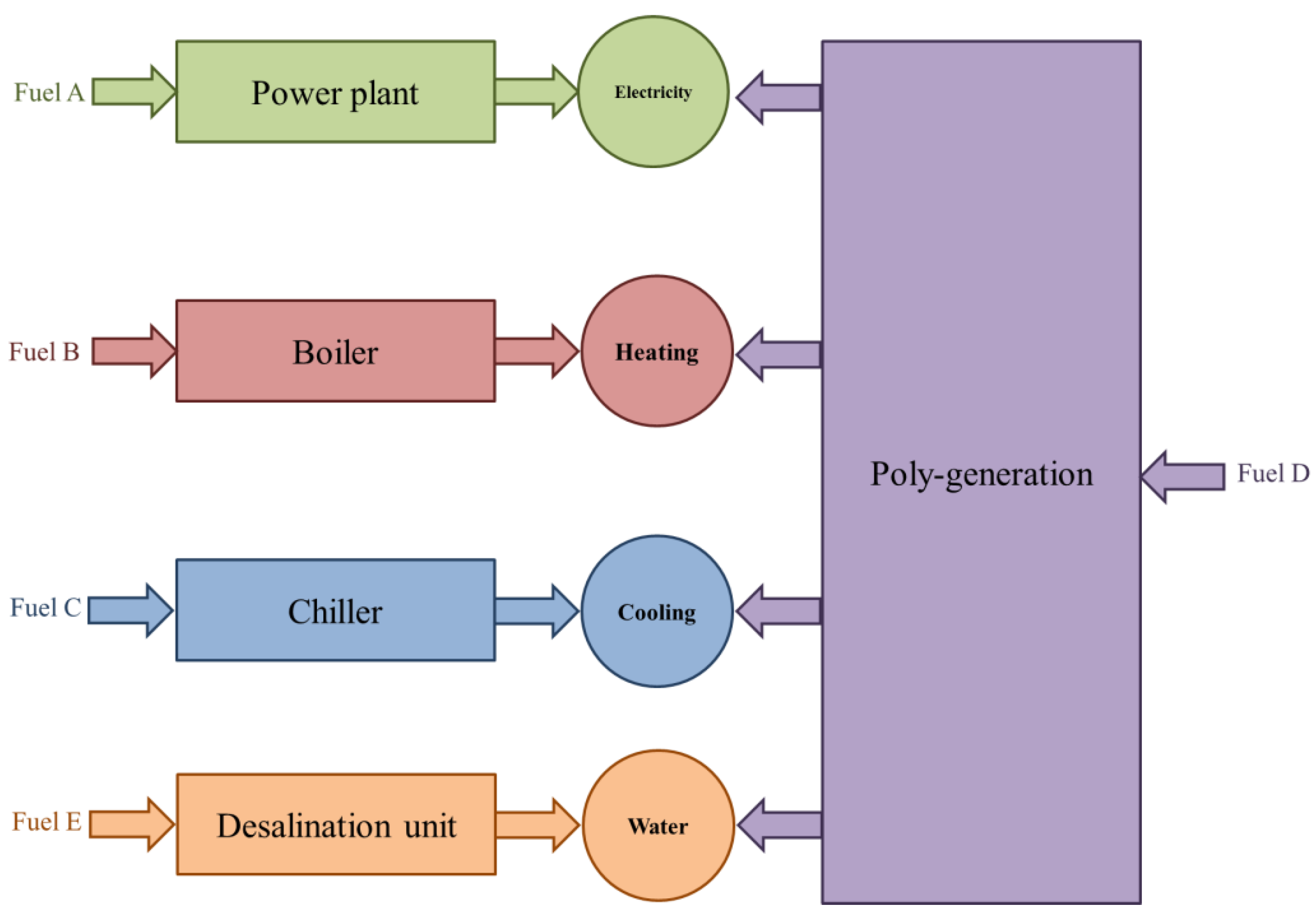
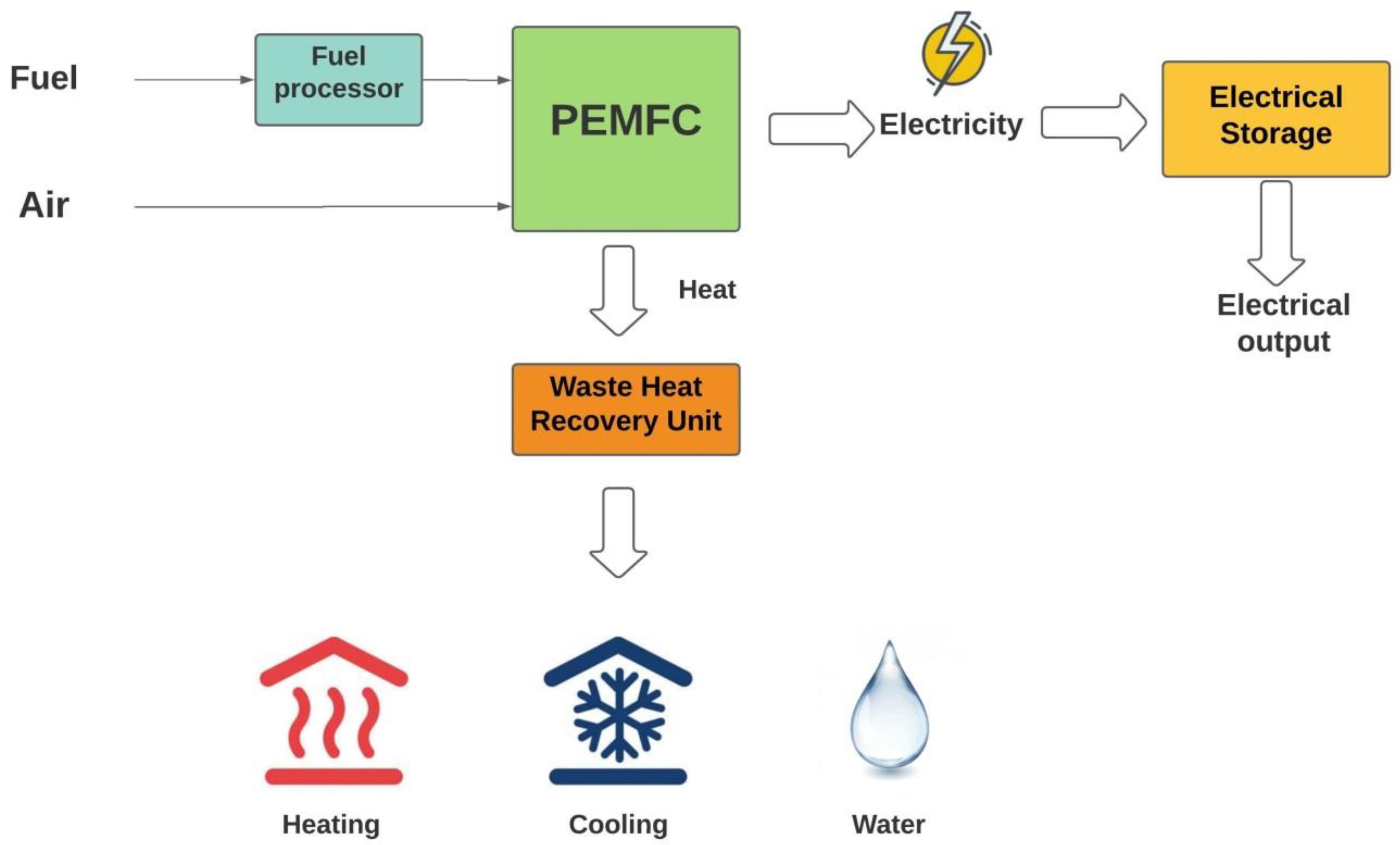
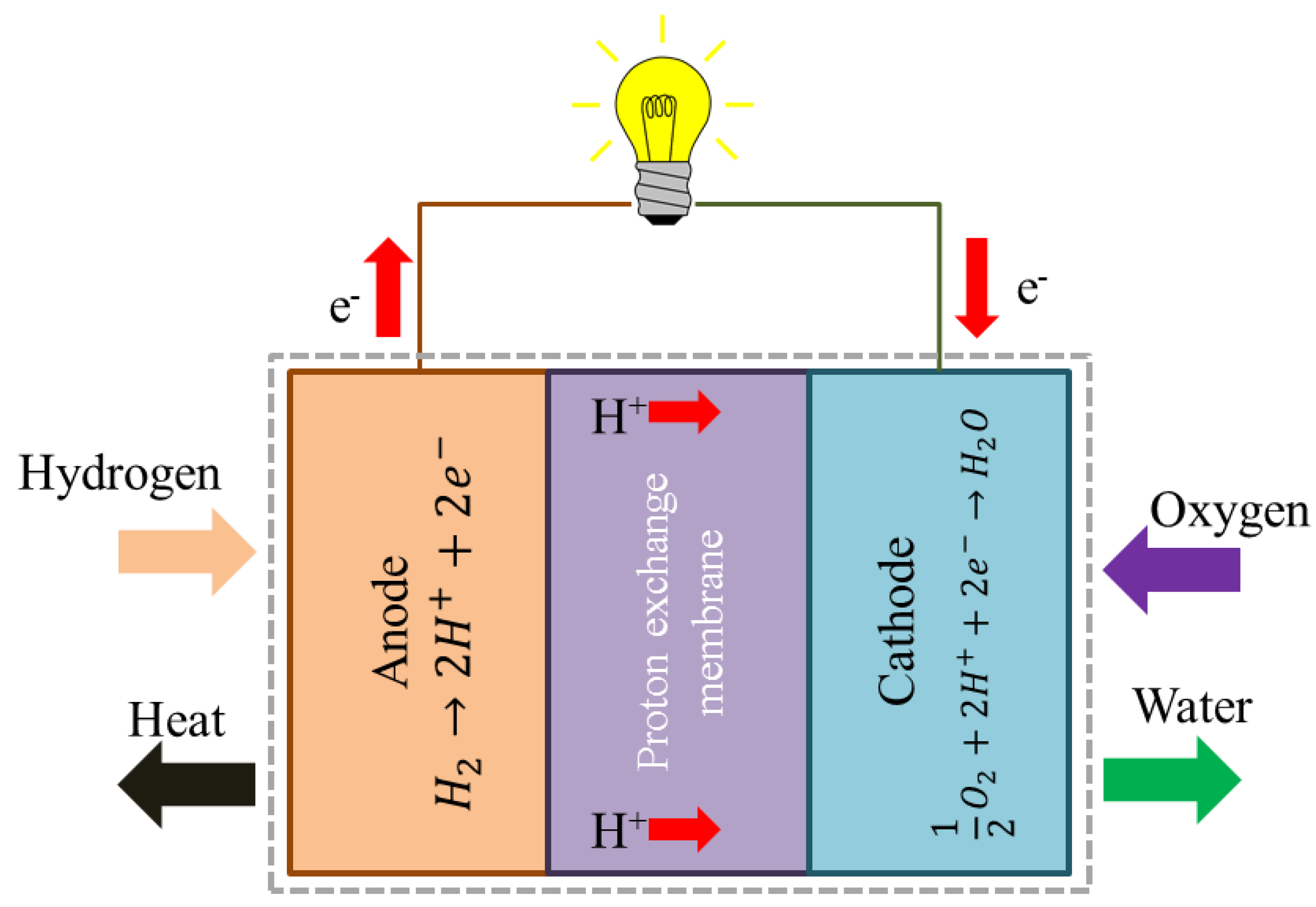

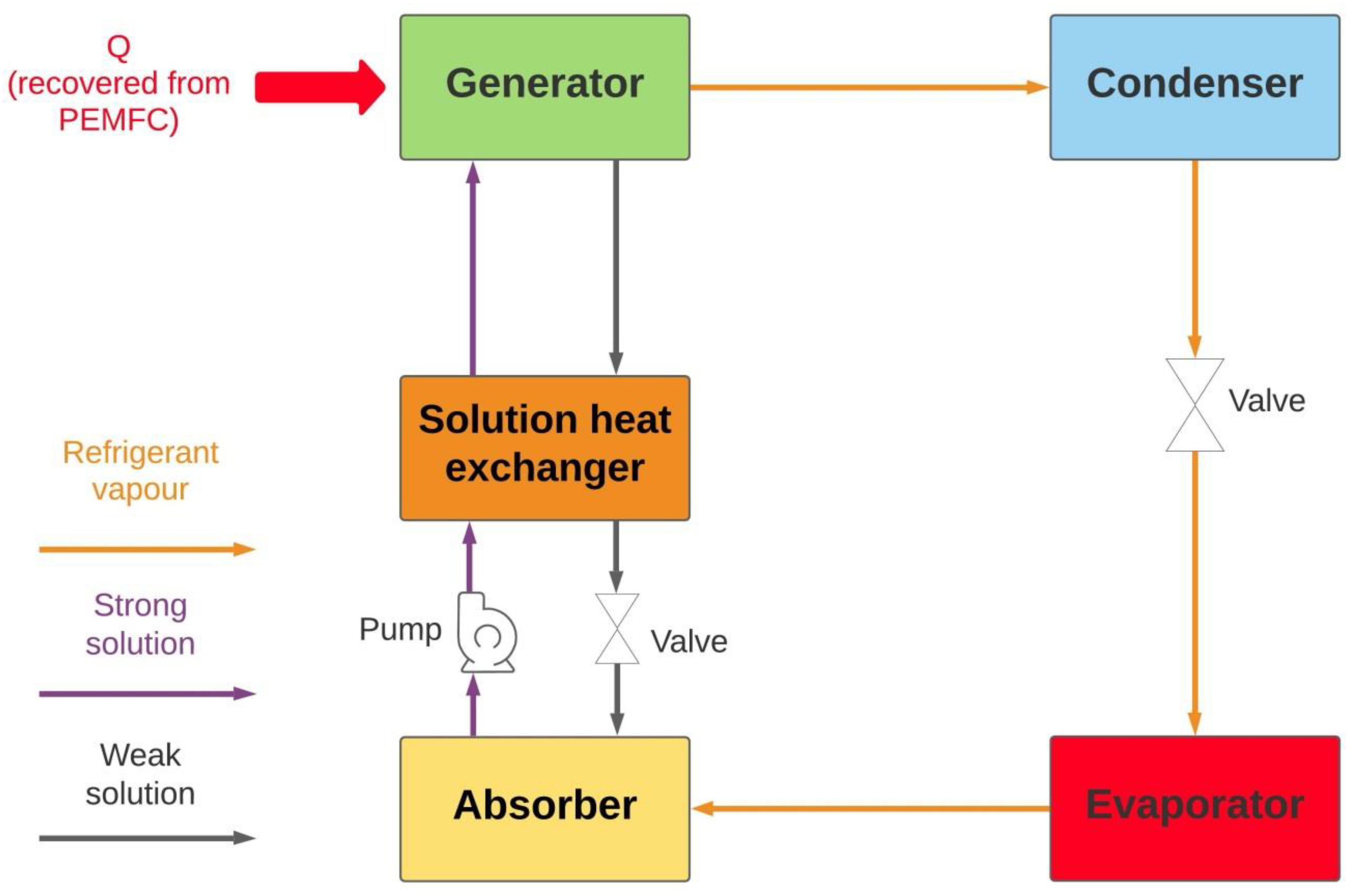
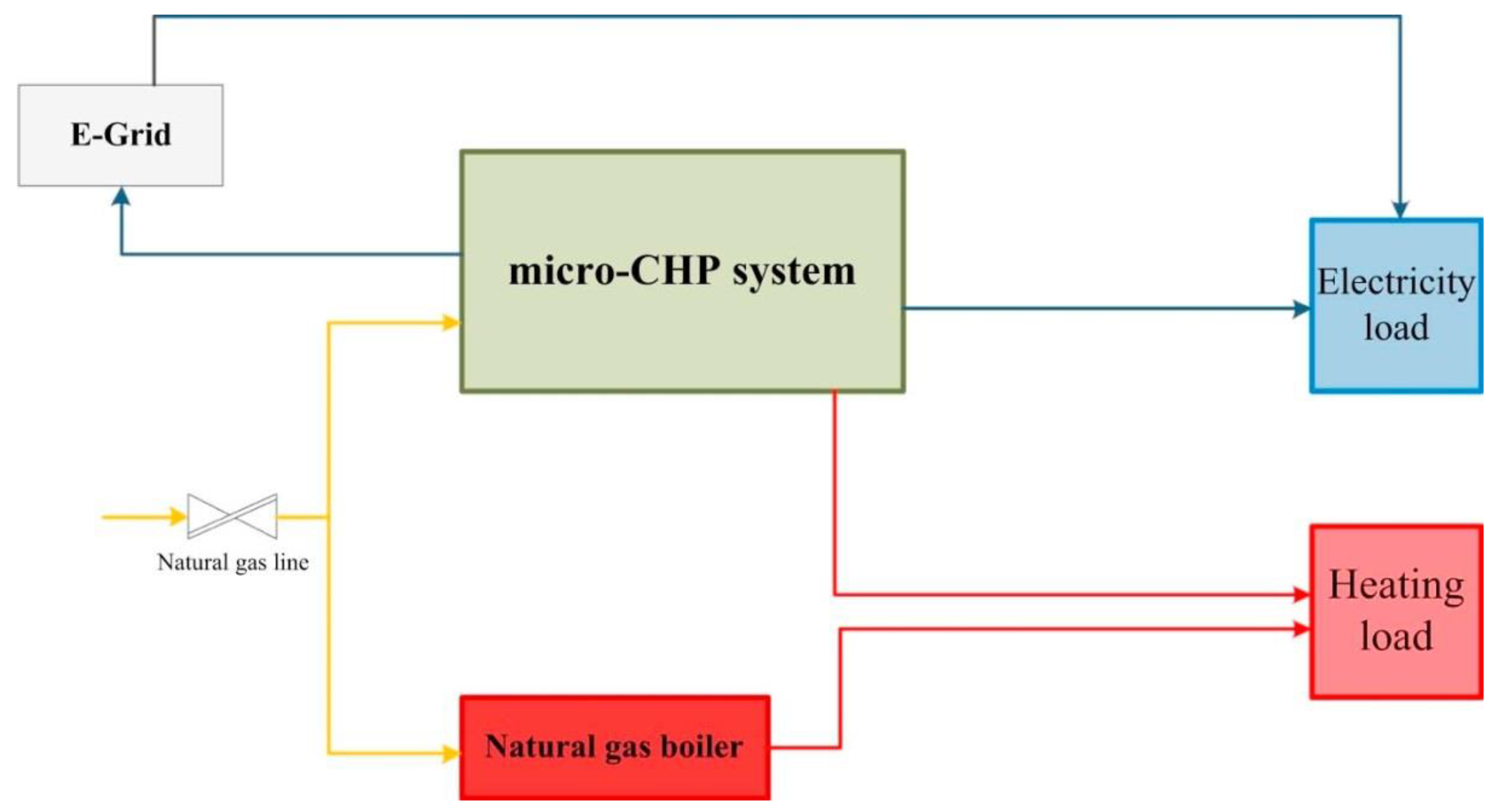
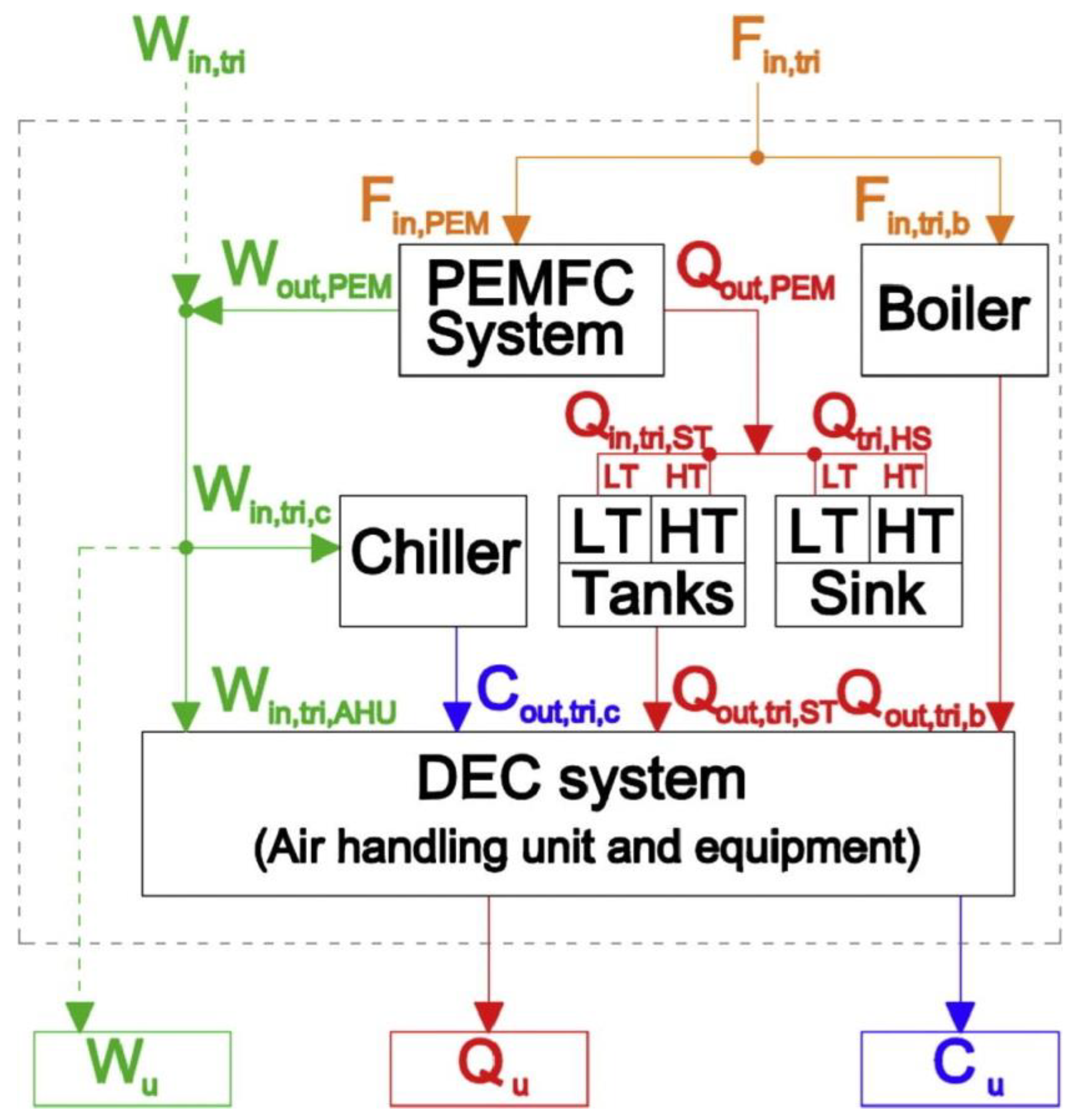
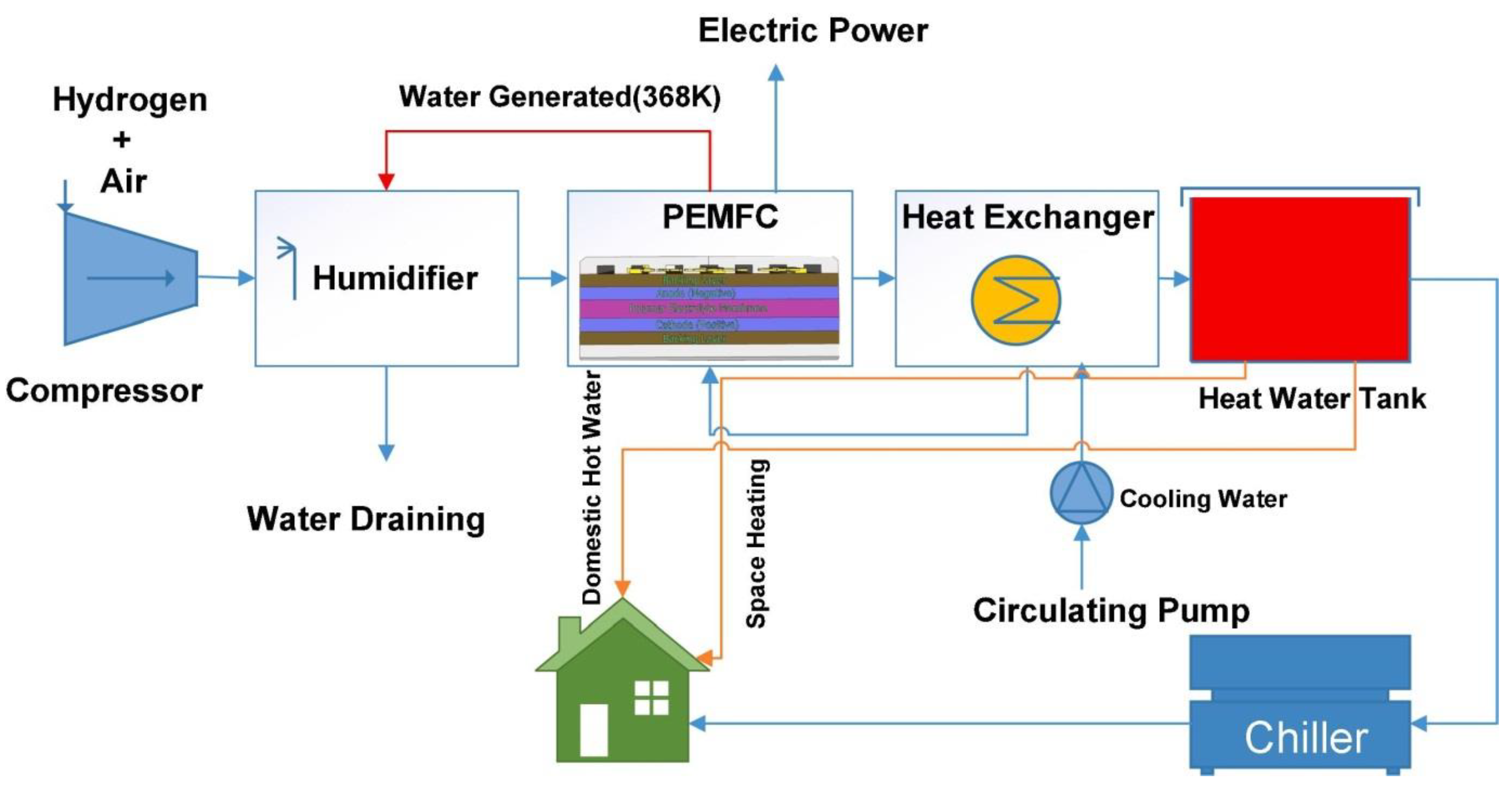
| Metric | Equation | Ref |
|---|---|---|
| The gross electrical efficiency | where : mass flow rate of the input fuel [kg/s] LHV: higher heating value of the fuel [kJ/kg] | [108] |
| The net electrical efficiency | where : The power consumed to operate the auxiliary services, such as pump and compressor, within the power plant. | [108] |
| The thermal efficiency | [108] | |
| The cooling efficiency | ||
| The system energy efficiency |
| [108] |
| [109] | ||
where: is the reference environment temperature is the hot-water temperature | [109] | |
where: is the temperature of the evaporator. | [109] | |
| [110,111] | ||
| Primary Energy Saving index (PES) | where are the reference efficiencies which refer to the efficiencies for the separate production of electricity and heat, respectively. | [108,112] |
| Levelized Cost Of Energy (LCOE) | = where CRF: capital recovery factor : installation cost (capital cost) : operation and maintenance costs | [113] |
| ) | : the maintenance cost : the initial system investment : the total fuel cost : the total running period | [114] |
Publisher’s Note: MDPI stays neutral with regard to jurisdictional claims in published maps and institutional affiliations. |
© 2021 by the authors. Licensee MDPI, Basel, Switzerland. This article is an open access article distributed under the terms and conditions of the Creative Commons Attribution (CC BY) license (https://creativecommons.org/licenses/by/4.0/).
Share and Cite
Baroutaji, A.; Arjunan, A.; Robinson, J.; Wilberforce, T.; Abdelkareem, M.A.; Olabi, A.G. PEMFC Poly-Generation Systems: Developments, Merits, and Challenges. Sustainability 2021, 13, 11696. https://doi.org/10.3390/su132111696
Baroutaji A, Arjunan A, Robinson J, Wilberforce T, Abdelkareem MA, Olabi AG. PEMFC Poly-Generation Systems: Developments, Merits, and Challenges. Sustainability. 2021; 13(21):11696. https://doi.org/10.3390/su132111696
Chicago/Turabian StyleBaroutaji, Ahmad, Arun Arjunan, John Robinson, Tabbi Wilberforce, Mohammad Ali Abdelkareem, and Abdul Ghani Olabi. 2021. "PEMFC Poly-Generation Systems: Developments, Merits, and Challenges" Sustainability 13, no. 21: 11696. https://doi.org/10.3390/su132111696
APA StyleBaroutaji, A., Arjunan, A., Robinson, J., Wilberforce, T., Abdelkareem, M. A., & Olabi, A. G. (2021). PEMFC Poly-Generation Systems: Developments, Merits, and Challenges. Sustainability, 13(21), 11696. https://doi.org/10.3390/su132111696











